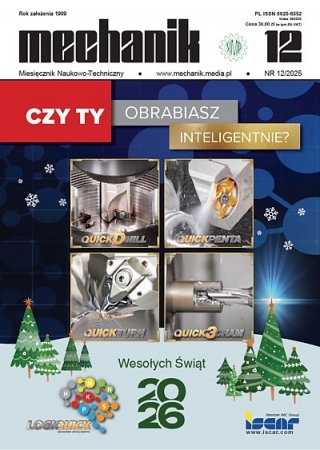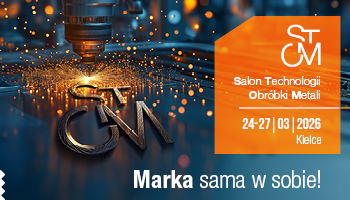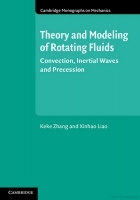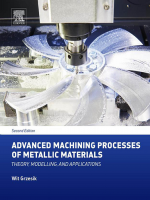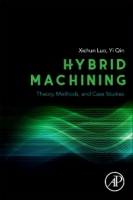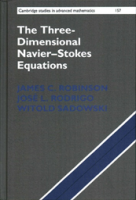Abrasive machining process supported by electrochemical dissolution and electrical discharges – state of the art and directions of development *
Obróbka ścierna wspomagana roztwarzaniem elektrochemicznym i wyładowaniami elektrycznymi – stan badań i kierunki rozwoju
Author: Adam Ruszaj, Mariusz Cygnar, Marcin Grabowski
Mechanik nr 10/2019 - Obróbka - inne rodzaje
ABSTRACT: For finishing machining parts made of alloyed steels, composite or ceramic materials hybrid methods as abrasive machining supported by electrochemical dissolution or/and electrical discharges are often applied. The range of these processes practical applications in industry significantly increases. Because of this fact in the paper results of investigations and examples of practical applications of the mentioned hybrid abrasive processes are presented.
KEYWORDS: special materials, hybrid methods, electrochemical abrasive machining, electrodischarge abrasive machining
STRESZCZENIE: Do obróbki wykończeniowej specjalnych stali stopowych, materiałów kompozytowych czy ceramicznych stosuje się zwykle metody hybrydowe, takie jak: obróbka ścierna wspomagana roztwarzaniem elektrochemicznym czy wyładowaniami elektrycznymi. Udział tych procesów w zastosowaniach przemysłowych istotnie wzrasta. Z tego względu w artykule przedstawiono aktualne wyniki badań i zastosowania wymienionych hybrydowych procesów obróbki ściernej.
SŁOWA KLUCZOWE: materiały specjalne, metody hybrydowe, obróbka elektrochemiczno-ścierna, obróbka elektroerozyjno-ścierna
BIBLIOGRAFIA / BIBLIOGRAPHY:
[1] Ruszaj A. „Niekonwencjonalne procesy kształtowania materiałów ceramicznych i kompozytowych”. Mechanik. 90, 3 (2017): 188–194, https://doi.org/10.17814/mechanik.2017.3.39.
[2] Lauwers B., Kocke F., Klink A., Tekkaya A.E., Neugebauer R., Micintosh D. “Hybrid processes in manufacturing”. CIRP Annals – Manufacturing Technology. 63, 2 (2014): 561–583, https://doi.org/10.1016/j.cirp.2014.05.003.
[3] Lauwers W. “Surface integrity in hybrid machining processes”. Procedia Engineering. 19 (2011): 241–251, https://doi.org/10.1016/j.proeng.2011.11.107.
[4] Hascalik A., Cydas U. “A comparative study of surface integrity of Ti-6Al-4V Alloy machined by EDM and AECG”. Journal of Materials Processing Technology. 190, 1–3 (2007): 173–180, https://doi.org/10.1016/j.jmatprotec.2007.02.048.
[5] Ruszaj A., Skoczypiec S. „Wybrane zagadnienia obróbki elektrochemiczno-ściernej”. Mechanik. 88, 2 (2015): 103–105, http://dx.doi.org/10.17814/mechanik.2015.2.20.
[6] Curtis D.T., Soo S.L., Aspinwall D.K., Sage C. “Electrochemical super-abrasive machining of a nickel – based aeroengine alloy using mounted grinding points”. CIRP Annals – Manufacturing Technology. 58, 1 (2009): 173–179, https://doi.org/10.1016/j.cirp.2009.03.074.
[7] Shaikh J.H., Jain N.K. “Modelling of material removal rate and surface roughness in finishing of bevel gears by electrochemical honing process”. Journal of Materials Processing Technology. 214, 2 (2014): 200–209, https://doi.org/10.1016/j.jmatprotec.2013.08.010.
[8] Koshby P., Jain V.K., Lal G.K. “Grinding of cemented carbide with electrical spark assistance”. Journal of Materials Processing Technology. 72, 1 (1997): 61–68, https://doi.org/10.1016/S0924-0136(97)00130-1.
[9] Menesis I., Koshy P. “Assessment of abrasion-assisted material removal in wire EDM”. CIRP Annals – Manufacturing Technology. 57, 1 (2008): 195–198, https://doi.org/10.1016/j.cirp.2008.03.135.
[10] Chen Y.F., Lin Y.Ch. “Surface modification of Al-Zn-Mg alloy using combined EDM with ultrasonic machining and addition of TiC particles into dielectric”. Journal of Materials Processing Technology. 209, 9 (2009): 4343–4350, https://doi.org/10.1016/j.jmatprotec.2008.11.013.
[11] Ruszaj A., Skoczypiec S. „Obróbka elektroerozyjno-ścierna – wybrane zagadnienia”. Mechanik. 88, 3 (2015): 210–215, http://dx.doi.org/10.17814/mechanik.2015.3.107.
[12] Hrivastava P.K., Dubey A.K. “Experimental modeling and optimization of electric discharge diamond face grinding of metal matrix composite”. International Journal of Advanced Manufacturing Technology. 69, 9–12 (2103): 2471–2480, https://doi.org/10.1007/s00170-013-5190-8.
[13] Sanjay K., Chak P., Venkateswara R. “Trepanning of Al2O3 by electro-chemical discharge machining (ECDM) process using abrasive electrode with pulsed DC supplay”. International Journal of Machine Tools & Manufacturing. 47 (2007): 2061–2070, https://doi.org/10.1016/j.ijmachtools.2007.05.009.
[14] Liew Pay Jun, Yan Jiwang “Micro-electrical Discharge Machining of Hard Brittle Materials”. Micro and Nano Fabrication Technology (ed. Yan Jiwang). Singapore: Springer Nature, 2018, https://doi.org/10.1007/978-981-13-0098-1_25.
DOI: https://doi.org/10.17814/mechanik.2019.10.85
* Artykuł recenzowany



